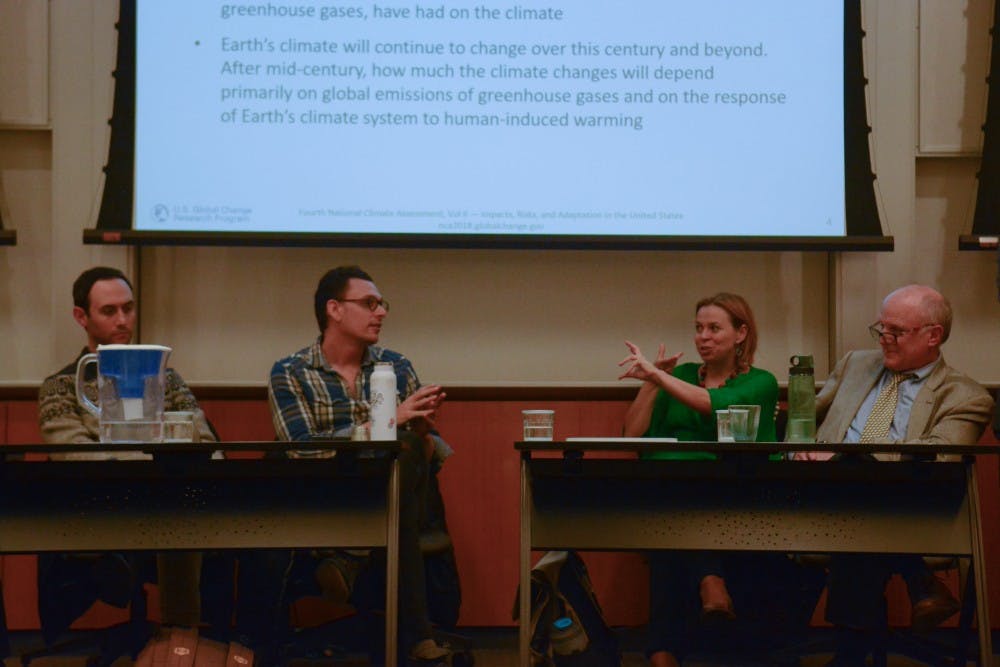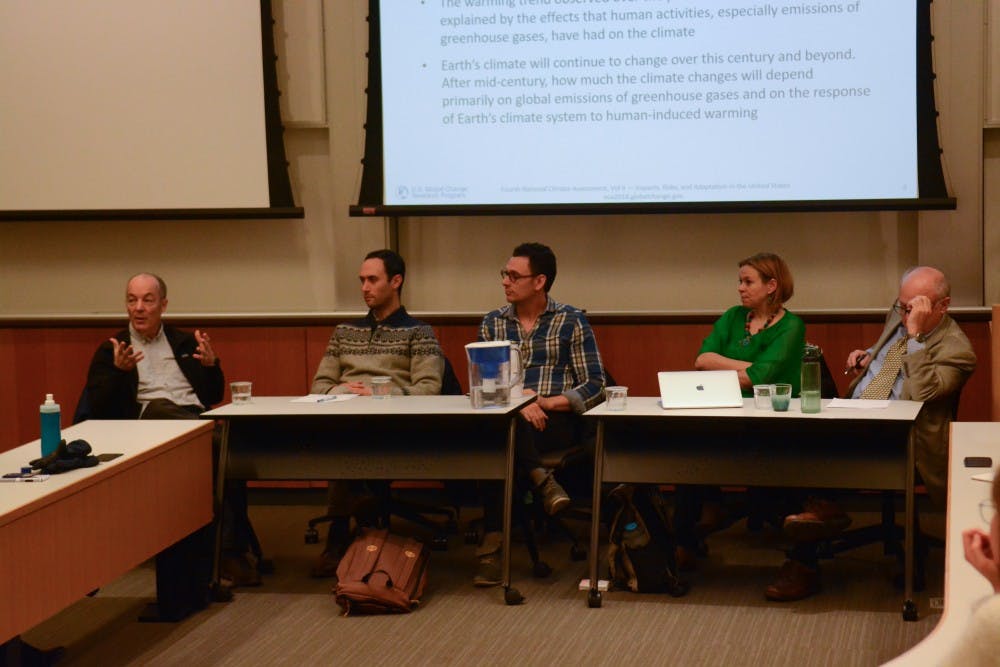
In the first collaborative panel hosted by the Climate Reality Project and the Penn Environmental Group, experts from the University addressed the significance of some of the most recent reports on climate change on Nov. 29.
Dubbed "T-Minus Twelve Years," the 90-minute presentation engaged students, faculty, and local activists in questions about the science, political importance, and social implications of climate change as they relate to Penn and to the rest of the world.
According to Climate Reality Project President and Wharton junior Kalyxa Roman, the motivation to host the panel came after the United Nations Intergovernmental Panel on Climate Change released a new assessment in October, and United States federal agencies published their own report on Nov. 23. Both sources warned of dangers of climate change to the environment and international economies at large.
“As student groups, I think we just hope to inspire some others to think about and see the action we need to take as feasible items," Roman said.
The conversation was led by PennDesign professor Billy Fleming, Earth and Environmental Sciences professor Irina Marinov, Chemical and Biomolecular Engineering professor Andrew Huemmler, Penn Sustainability Office’s Sustainability Manager Julian Goresko, and Architecture professor Bill Braham.
All five speakers agreed that more needs to be done across the board to raise awareness and to respond to imminent threats, such as wildfires and floods. Whether through improved architectural structures, the use of cleaner energy sources, or simply making the facts accessible, they suggested that there are plenty of ways to address climate change.
Particular attention was brought to the drastically different approaches taken by American politicians towards environmental issues.
Huemmler, who talked about the potential of nuclear and renewable energy sources as replacements for oil and gas, noted that political candidates’ willingness to accept donations and sponsorship from the latter two industries could potentially serve as a roadblock even though some progress has been made in states like Texas.

“We’re still on the edge politically as to how the future’s going to unfold,” Huemmler said.
Fleming, who worked on urban policy development under the Obama administration, recalled having to “field panicked calls and texts” from colleagues in the transition to a more conservative White House with reduced funding to organizations like the Environmental Protection Agency.
He did note, however, that “at this point, [industries] know they’re going to have to do something on the mitigation side,” which will likely start with the imposing of carbon taxes.
“What really struck me was how the entire panel concurred that climate change is an almost entirely political issue,” College freshman Vyshnavi Kosigi said. “While in theory climate change should be a non-partisan issue, where governmental leadership is vital, industry has stepped up and become the de facto pioneer in fighting, quite literally, the greatest threat to humanity.”
The event also comes at a time of uncertainty surrounding the role Penn can and should play in the effort to understand and control climate change.
While Penn’s 2017 Sustainability Report claimed there was progress on some of the goals the University set in the 2014 Climate Action Plan 2.0, the Department of Earth and Environmental Science still lacks faculty specializing in climate change or sustainability.
Marinov, who spoke at the panel and is Penn’s only standing faculty member at Penn studying climate change, previously told The Daily Pennsylvanian that “the problem here is that the University is not truly investing in the expansion of this department of Earth and Environmental Science.”
During the panel, Marinov further questioned the lack of a “detailed or very specific plan” put forth by Penn.
In response, Braham referenced documents like Penn’s annual sustainability frameworks, projecting that in less than three decades, the University could have a “neutral carbon footprint.” That is, it could release a net total of zero carbon emissions into the atmosphere.
While the University Council Steering Committee recently rejected Fossil Free Penn’s second official attempt towards fossil fuel divestment, the panelists acknowledged that there are at least some signs of decarbonization around the institution.
The University has used its marketing power to help nearby power plants switch to less carbon-intensive steam, and the local grid is seeing more natural gas use, Braham said. One of the next steps, according to him, is to look towards solar and wind power sources.
“You have to be an optimist to design for the future,” said Braham, who currently serves as the director of the Master of Environmental Building Design and of the Center for Environmental Building & Design. He later added that while climate change often appears as an isolated problem for climate scientists, engineers, and architects, every discipline at Penn has a role to play.
“So many times the topic is approached with just science, and that can alienate people. I’m glad the panelists were able to show other sides of climate change,” said College freshman Marina Dauer, who helped organize the event.
“There are solutions out there, as our panelists can speak to, and they now need to become front-of-mind for everyone,” Roman added.
The Daily Pennsylvanian is an independent, student-run newspaper. Please consider making a donation to support the coverage that shapes the University. Your generosity ensures a future of strong journalism at Penn.
Donate






